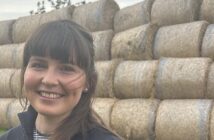Accurately determining Soil Nitrogen Supply during the spring could enable Nitrogen (N) applications on crops of oilseed rape and winter wheat to be reduced by an average of 60 kg N/ha – equivalent to a saving of £46/ha at current prices – on fields where the level of Additional Available Nitrogen (AAN) is expected to be high, such as where organic matter is high or where organic manures have been used. Across all fields the average saving would be 30kg N/ha or £23/ha. Nitrogen losses to the environment could also be greatly reduced, according to leading researcher Dr Mechteld Blake-Kalff from Hill Court Farm Research Ltd.
Addressing the International Fertiliser Society’s Annual Conference in Cambridge, Dr Blake-Kalff explained that recent trials* comparing the estimated N requirements for winter wheat against the ‘optimum’ N level identified post-harvest showed that predicted N requirements were within 50kg/ha of this level on only 25 of the 50 fields surveyed. The main reason for this was inaccurate estimation of Soil Nitrogen Supply (SNS). Although economic losses resulting from sub-optimal crop performance were small in cases where N applications were within 50kg/ha of optimal levels, larger errors were more serious in terms of their adverse impact on yield and profitability, with under-fertilising and over-fertilising causing similar losses.
Dr Blake-Kalff stated: “The standard Soil Mineral N (SMN) sampling method* only includes an estimate of additional N mineralisation, so a more accurate determination of Additionally Available Nitrogen (AAN) in the soil has the potential to provide farmers with considerable cost saving and environmental benefits. However, experiments to determine the Potentially Mineralisable Nitrogen (PMN) fraction in the soil have often shown a poor relationship between the mineralised pool and crop N offtake. The reason for this is that the incubation method used results in relatively high N values which do not reflect field conditions in a temperate climate.”
Determining the amount of N which is mineralised from organic matter from the time when soil sampling is carried out in the spring through to harvest provides scope to improve the accuracy with which the level of Additional Available Nitrogen (AAN) is assessed. To quantify this, Dr Blake-Kalff and Dr Laurence Blake examined data from three research projects in the UK. These comprised long-term field trial sites used by GrowHow UK for N fertiliser monitoring, a three-year project conducted by GrowHow and Agrii to monitor N changes throughout the growing season in oilseed rape, together with the three-year HGCA SNS Project which was managed by ADAS.
Their study found that including data for AAN, which is a feature of the GrowHow N-Min® Nitrogen management service, improved the prediction of SNS or fertiliser N requirement when measured against N offtake at harvest, such that for all soil types SNS explained about 62% of the variation in crop N uptake.
The project concluded that where the AAN is relatively high, namely where the Soil Organic Matter was greater than 5% and the Carbon: Nitrogen (C:N) ratio was 10-15, considerable reductions in N fertiliser applications could be made without any significant reduction in crop yield. This was particularly evident in crops of oilseed rape and wheat. For example, by accounting for AAN in wheat, fertiliser applications could be reduced by an average of 60 kg N/ha, equivalent to a £46/ha saving at current fertiliser prices, although maximum savings could exceed 100kg N/ha with correspondingly greater financial savings.
GrowHow Arable Agronomist Allison Grundy states: “This work confirms that the GrowHow N-Min service, which incorporates the GrowHow Nitrogen Calculator (N-Calc), enables farmers to accurately determine fertiliser N requirements, optimise crop performance and improve their environmental credentials. “N-Min is the only Nitrogen test to measure both Soil Mineral Nitrogen (SMN) and Additional Available Nitrogen (AAN), providing farmers with an accurate prediction of the Total Nitrogen that will become available to crops throughout the growing season. It is this dual approach which makes it uniquely accurate.”



